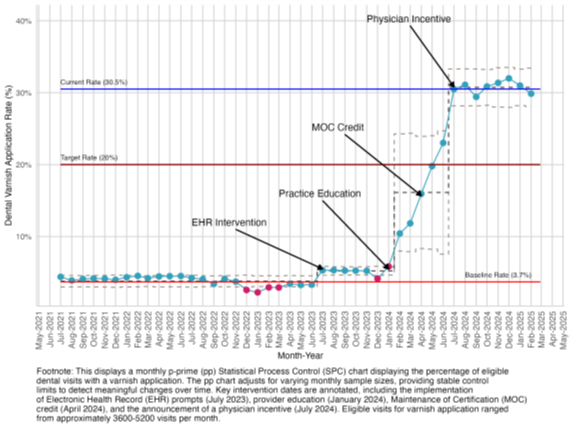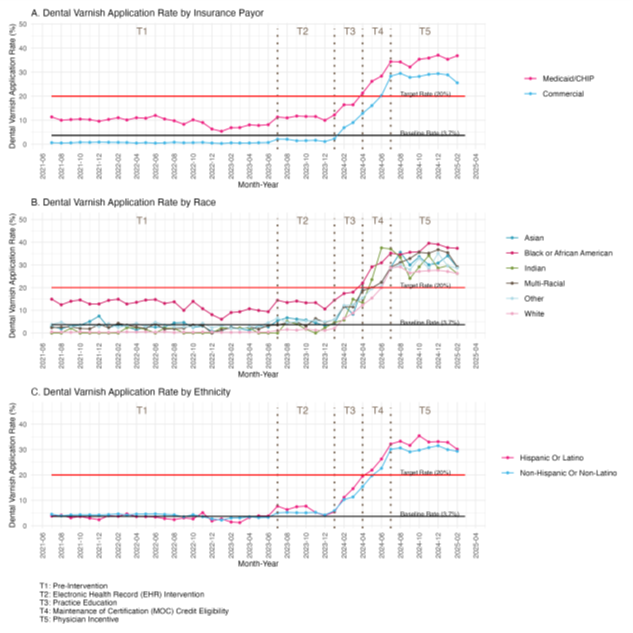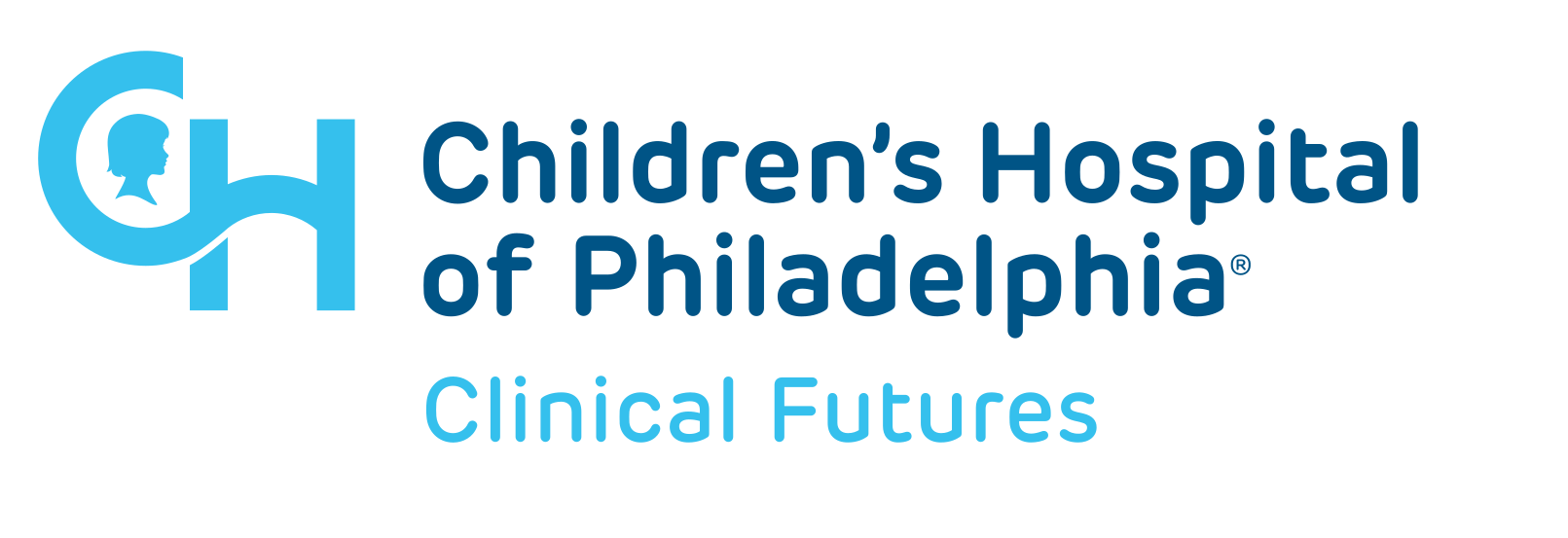Research In Practice Blog
Breadcrumb

Increasing Dental Varnish Rates in a Large Pediatric Care Network: A Quality Improvement Effort
Intro
A new study published in Pediatrics investigates how researchers from Children’s Hospital of Philadelphia (CHOP) and Clinical Futures have successfully and effectively scaled dental varnish application across the primary care network using iterative quality improvement (QI), electronic health record (EHR) design, and change management strategies.
Dental fluoride varnish is widely recognized as a safe and effective treatment that significantly reduces the risk of cavities in young children, without the risk of fluorosis. Clinical guidelines, including those from the U.S. Preventive Services Task Force and American Academy of Pediatrics, recommend that all children aged 5 years and younger receive fluoride varnish every 3 to 6 months during pediatric primary care visits.
The COVID-19 pandemic has worsened children's oral health, highlighting the urgent need to enhance preventive dental care within the pediatric primary care setting. Despite the fact that dental varnish is covered by both commercial and Medicaid insurance—with no out-of-pocket costs for families—national rates of varnish application remain low. Currently, fewer than 10% of children with Medicaid insurance and only 5% of children with commercial insurance receive fluoride varnish at their pediatrician's office. Additionally, there are persistent disparities in access to dental care and the receipt of fluoride varnish based on the race and ethnicity of the children.
Study Design and Findings
This project was implemented within the CHOP Care Network, which, during the intervention period, included 33 different practices in urban, suburban and semi-rural settings, serving approximately 320,000 patients overall, and 105,217 patients aged 6 months to 5.99 years in Pennsylvania and New Jersey. The network includes both teaching and non-teaching practices, each staffed by 3 to 50 pediatricians and nurse practitioners. Primary care providers included approximately 235 pediatricians, 75 nurse practitioners and 160 residents.
Researchers sought to address two related problems:
- Few practices regularly applying dental varnish to children who were eligible.
- Significant disparities were observed based on insurance type, with only 0.7% of eligible visits receiving varnish for children with commercial insurance, compared to 9.1% for those insured by Medicaid.
Although access and coverage barriers do not explain this disparity, as both insurance types cover varnish without copays, provider-level factors such as knowledge gaps, workflow integration challenges, and assumptions may contribute to different application rates.
The objective of this project was to implement a quality improvement (QI) intervention aimed at increasing the rates of dental varnish application across CHOP's extensive primary care network, which serves a high volume of children with commercial or Medicaid insurance. The main aims of the study included:
- Increasing the percentage of eligible preventive visits for children aged 6 months to 5.99 years, during which dental varnish is applied, from 5% to 20% after one year of intervention.
- Increasing dental varnish rates for all children, regardless of their insurance type, race, or ethnicity. Researchers monitored these factors as a balancing measure. Although the intervention was not specifically tailored to individual insurance or racial subgroups, the researchers tracked these characteristics throughout the implementation to identify and address potential disparities in order to prevent worsening disparities.
Methods and Results
There were 102,881 eligible preventive care visits during the baseline pre-intervention period and 92,056 in the intervention period. Patient characteristics were comparable across time periods. At baseline, dental varnish was applied at 3.7% of eligible visits. Researchers implemented intervention components iteratively, guided by real-time reviews of outcome data and provider feedback. After an initial EHR prompt was launched in July 2023, physician feedback prompted the addition of targeted education in January 2024 followed by maintenance of certification (MOC) credit with audit-and-feedback meetings in April 2024. These components were associated with three significant centerline shifts in varnish rates July 2023, January 2024, and May 2024, respectively (see Figure 3). By May 2024, researchers met their SMART aim of 20%, and by July 2024 varnish rates reached 30.5%.

Researchers assessed balancing measures using run charts and confirmed that dental varnish application rates increased across all groups, regardless of child insurance type, race, or ethnicity (see Figure 4).

Following implementation, dental varnish application rates increased significantly across all demographic subgroups (p < 0.001 for all comparisons). Improvements were observed for both Medicaid/CHIP and commercially insured patients, as well as across all racial and ethnic groups
The QI intervention resulted in improvements across all RE-AIM measures. For reach, the visits at which dental varnish was applied increased from approximately 400 visits a month, during the baseline period, to more than 4,000 a month through the intervention period. For effectiveness, the proportion of individual children who received at least one dental varnish during the past year increased from 25% at baseline to more than 50% during the intervention period. This differed from the visit-level outcome (varnish at 3.7% of eligible visits pre-intervention), since many children had multiple visits.
For adoption, by the end of the intervention period, all 33 practices had adopted dental varnish application. Adoption occurred gradually, beginning with 6 practices participating at baseline. After the introduction of EHR prompts in July 2023, the number of participating practices grew steadily, reaching 29 practices that applied dental varnish by June 2024. Following the announcement of the financial incentive tethered to performance in July 2024, the remaining 4 practices adopted varnish application. Finally, for maintenance, annual reimbursement increased from $154,540 at baseline (July 2022–June 2023) to $416,006 through the intervention (July 2023–June 2024), demonstrating financial sustainability.
What’s Next? Informing Future Clinical Practice Guidelines
This system-wide intervention, which utilized an EHR-enabled quality improvement (QI) approach, significantly enhanced the application of dental varnish for all children, irrespective of their insurance type, race, or ethnicity. The strategy integrated an electronic health record (EHR) workflow with change management techniques such as education, professional certification credits, and financial incentives, showcasing its potential as a scalable model for incorporating dental varnish into pediatric primary care.
Beyond improving implementation, this QI intervention demonstrated broad reach, effectiveness, adoption, and sustainability. Long-term maintenance of these improvements can be supported through increased reimbursements associated with higher varnish application rates, aligning with the business models of healthcare settings. These findings underscore the importance of aligning financial incentives with quality objectives to facilitate significant improvements. As healthcare payment models continue to evolve, policymakers and health systems should consider integrating preventive oral health initiatives into value-based payment frameworks.
"Our findings provide important insights that can help pediatricians improve the administration of dental varnish to their patients. We hope that other primary care networks can adopt and implement these effective intervention strategies to boost dental varnish rates for patients across the United States on a larger scale,” said Brian Jenssen, MD, MSHP, Associate Director of the Clinical Impact at Clinical Futures at CHOP.
Learn more in this CHOP press release.
Clinical Futures author(s): Brian P. Jenssen, MD, MSHP; Gabrielle DiFiore, MPH
Additional authors; Tyler Doherty, MHA; Steve Callum, MBA; Stephanie Gilbert, MBA; Elena Huang, MD; Lisa Biggs, MD; Gregory Lawton, MD, FAMIA
Citation:
Jenssen et al, “Increasing Dental Varnish Rates in a Large Pediatric Care Network: A Quality Improvement Effort.” Pediatrics. Online September 18, 2025. DOI: 10.1542/peds.2025.069877.
